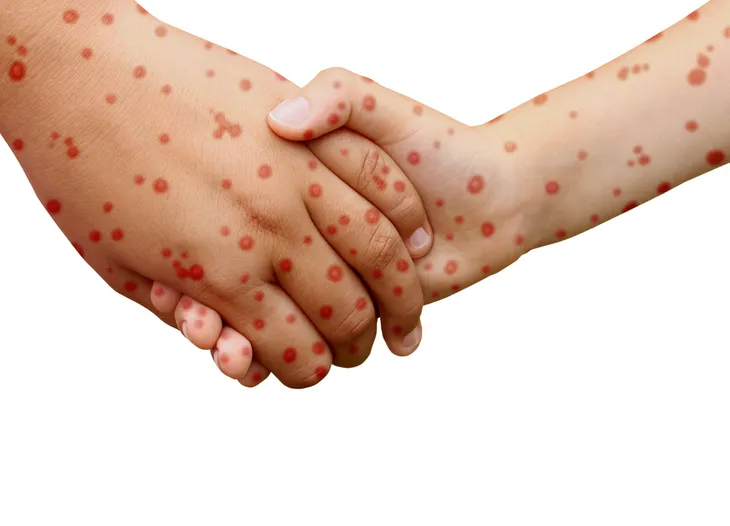Measles, a condition medically known as rubeola, is highly contagious. In fact, the disease is responsible for a total death toll of approximately 200 million individuals.
Brought about by the infectious rubeola virus, the measles is a highly endemic illness, meaning the virus can lie dormant among communities that are resistant to the disease. However, if the rubeola virus affects a community that’s never been exposed to measles, the consequences can be both destructive and deadly.
The measles virus breeds in the mucus of the nose and throat of infected individuals. Those who are contagious can spread measles up to 4-days prior to the presence of symptoms and for another 5 days after. To get informed on this illness, read about all the warning signs and symptoms of measles…
1. Fever
A mild to high fever may be the first sign of the measles virus. However, it can be mistaken for influenza. This fever can go from mild to severe (105-degrees Fahrenheit) in a matter of days, spiking when the victim develops a skin rash. When the fever subsides, typically, so does the measles rash.
2. Measles Rash
This blotchy, reddish-brown skin rash typically develops 4-days after viral exposure. Usually it starts with blotchy discoloration on the face, particularly around the hairline, then gradually extends to the neck, shoulders, arms, torso, legs, and feet.
3. Cough
A harsh, dry, irritated cough is another telltale sign of measles. The differentiator between a cough due to cold vs. a cough due to measles virus is that the measles cough is often unaffected by cough syrups and other over-the-counter remedies. In fact, the rubeola virus spreads primarily through mucus droplets passed with coughing.
4. General Malaise
The initial symptoms of the measles are easily confused with influenza or the common cold, primarily because one of the first signs of measles is general malaise, which includes muscle aches, fatigue, and generalized pain. The problem with this is that it’s also prevalent with an assortment of other viral infections, such as the cold and flu.
5. Nasal Congestion
The measles virus will cause a nasal congestion, runny nose, and sneezing in the early stages. Again, this nasal congestion will not be soothed by over-the-counter cold medications or decongestants. The virus is spread through mucus, which often remains contagious for a few hours following a sneeze or contact with another person.
6. Mouth Sores
Koplik spots are indicative of the measles a few days prior to developing a measles rash. They form as clustered, white lesions on the buccal mucosa (near the lower molars, inside the mouth and back of the throat). These spots are often likened to tiny white salt particles with blue-white centers.
7. Pink Eye
Conjunctivitis, or pink eye, commonly accompanies a case of the measles. One or both eyes become red, swollen, and watery. In addition, one or both eyelids can become painfully inflamed and itchy, emitting thick, yellow-white mucus.
8. Sensitivity to Light
As a patient’s measles rash worsens, they may become painfully sensitive to light. This condition, called photophobia, will call for rest in a dimly lit or dark room. Any exposure, even to natural light, may call for sunglasses to avoid pain and eye irritation.
9. Fatigue
One of the most common early warning signs of most illnesses is when the body begins to feel run-down, lethargic, and just overall fatigued. This is because our immune system is working overtime to fight off whatever infection has us feeling down. When it comes to the measles, it’s no different.
Fatigue can be hard to spot because we all feel tired from time to time, so this one might be easier to notice in children who are usually full of energy, as opposed to adults. Parents should look for signs of unusual fatigue or tiredness in their child.
10. Irritability
Now that we’ve listed the most common symptoms associated with the measles, you’ve probably noticed that they aren’t pleasant. Accordingly, this last symptom shouldn’t be all that surprising. The Government of Canada website lists irritability as another common symptom to watch for when it comes to the measles.
This could be an early warning sign that something is wrong. Children who aren’t feeling well and who’ve contracted the measles might become more irritable than usual or appear to “feel cranky or in a bad mood,” writes the source.
11. Contagious Period
For those who have not been vaccinated, the measles is extremely contagious. Anyone can catch it, including adults, children, and seniors. WebMD writes, “Just a cough or sneeze from an infected person launches the measles virus into the air, where you can breathe it in.” This means it’s extremely hard to protect yourself from it (unless you have been vaccinated).
The source goes on to explain when the measles is most contagious, which is 4-days before the rash appears and 4-days afterwards. “The virus can live for up to 2-hours on a surface or in the air,” writes WebMD. “You can get it if you touch an infected surface and then touch your mouth, nose, or eyes.”
This illness is so contagious that 90-percent of people who aren’t vaccinated will get the disease if they are close to someone who has it.
12. Complications
The measles itself can be deadly as the disease still kills more than 100,000 people a year, says the Mayo Clinic. Many of these people are under the age of 5-years-old. One of the reasons for this is because there are many complications that can arise from the measles.
The source lists an ear infection, known clinically as otitis media, as the most common complication, but it can also lead to more serious conditions, such as bronchitis, laryngitis, or croup, which causes inflammation in the main air passageways, or bronchi. It can also lead to pneumonia, encephalitis, and pregnancy complications.















